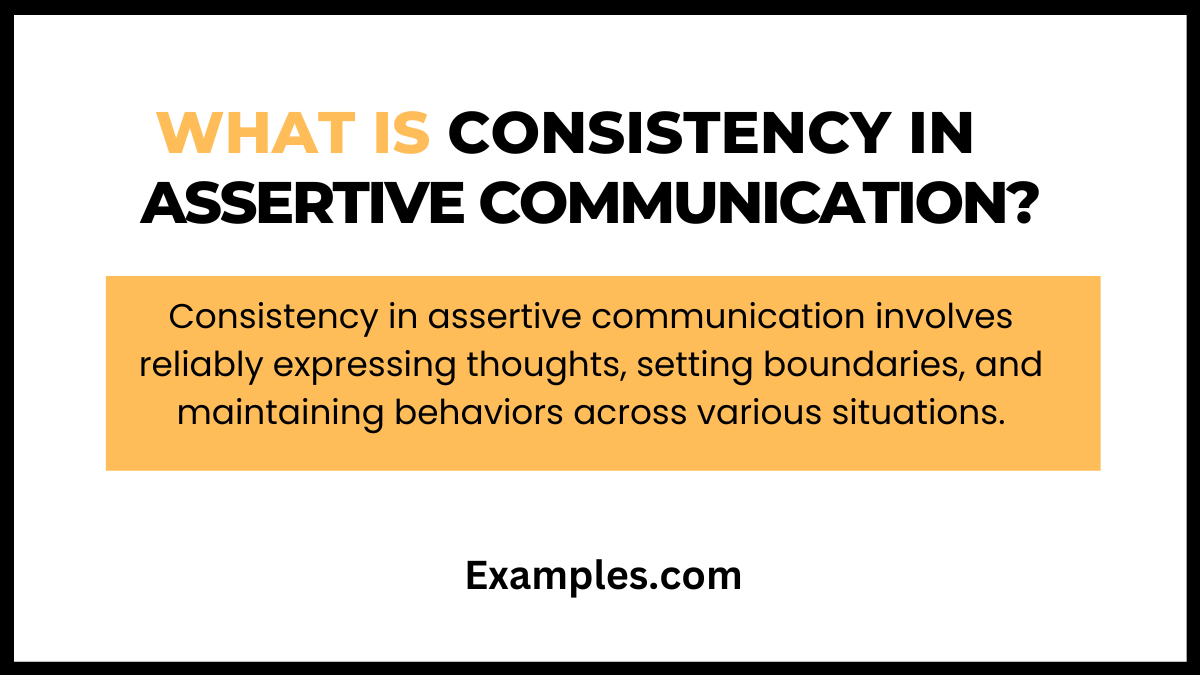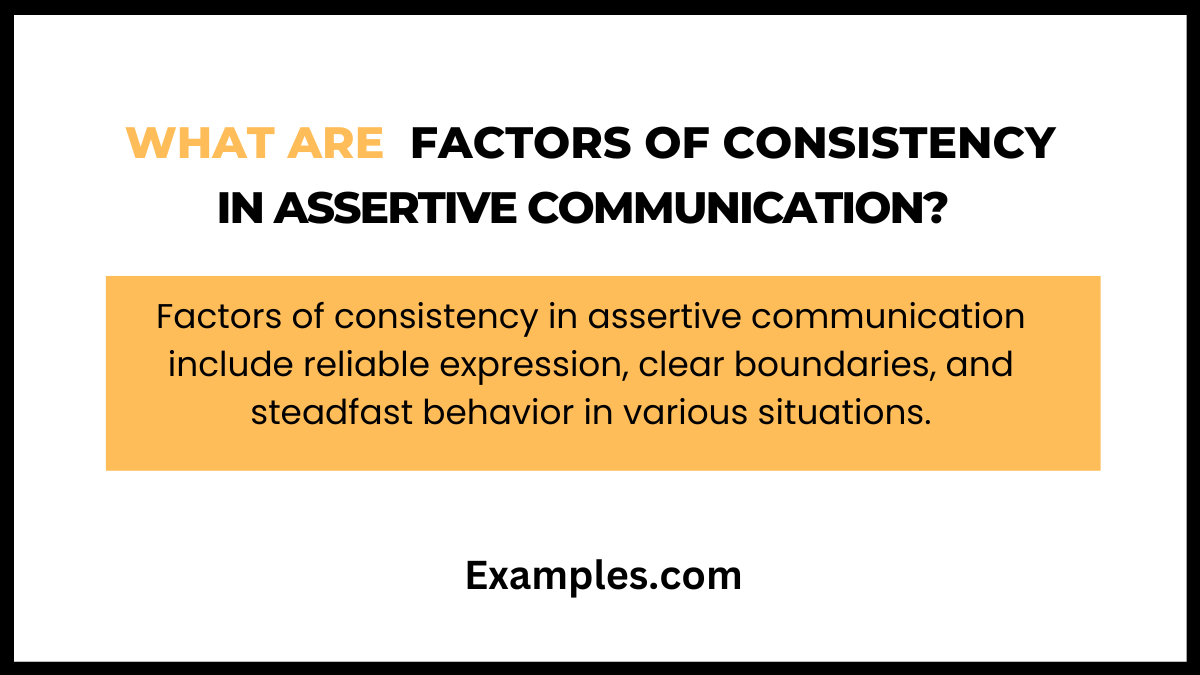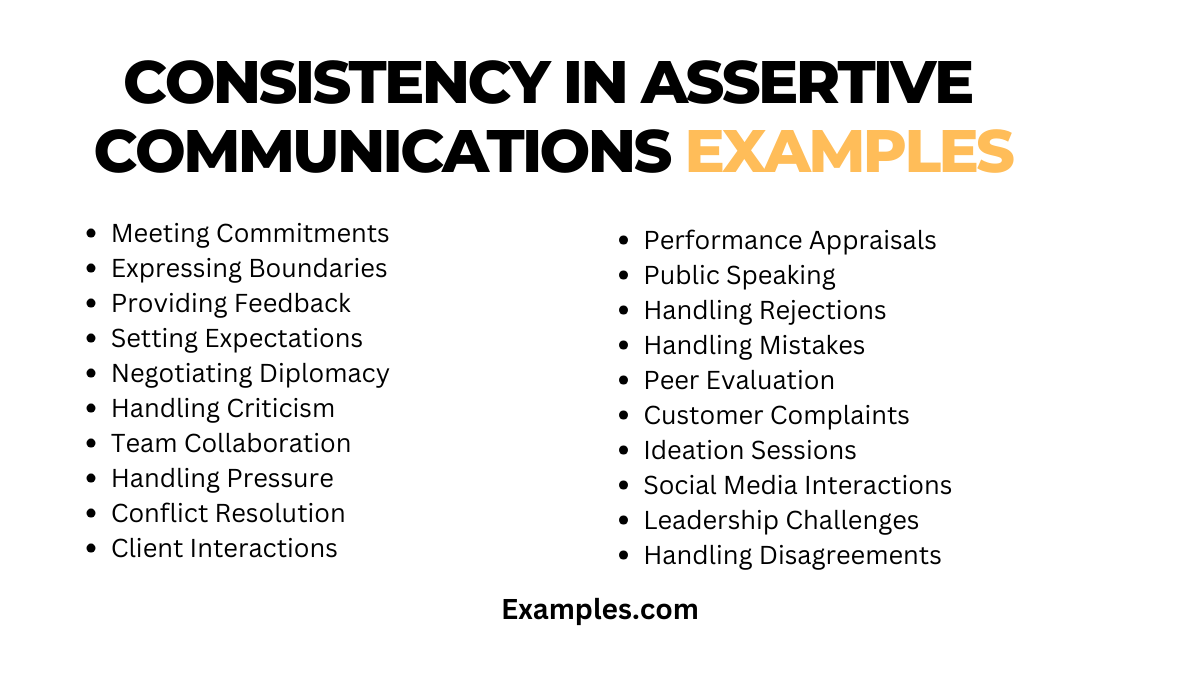19+ Consistency In Assertive Communication Examples
Consistency in assertive communication involves maintaining a uniform and reliable approach in expressing your thoughts, needs, and boundaries. It ensures clarity and builds trust, fostering effective interactions. In this guide, explore the essence of consistency, understand its significance, and delve into real-world communication examples to enhance your assertive skills.
What is Consistency In Assertive Communication?

Consistency in assertive communication refers to the reliability and coherence in expressing your thoughts, feelings, and boundaries. It involves aligning your verbal and nonverbal cues consistently, fostering trust and clarity in interactions. Maintaining a steady and predictable communication style contributes to effective assertiveness, enabling constructive and respectful conversations.
20 Consistency In Assertive Communication Examples
Consistency in assertive communication ensures reliable expressions of thoughts and needs. Explore these examples to refine your communication style:
- Meeting Commitments: Consistently deliver on promises, reinforcing trust in professional relationships.
- Expressing Boundaries: Clearly communicate personal limits, maintaining a consistent stance in various situations.
- Providing Feedback: Offer feedback consistently, emphasizing constructive aspects while guiding improvement.
- Setting Expectations: Communicate expectations consistently, ensuring clarity in personal and professional interactions.
- Negotiating Diplomacy: Consistently seek compromise during negotiations for effective and mutually beneficial agreements.
- Handling Criticism: Respond to criticism consistently, acknowledging valid points and addressing concerns diplomatically.
- Team Collaboration: Maintain consistency in valuing diverse opinions for innovative solutions and a harmonious work environment.
- Handling Pressure: Demonstrate self-control consistently in high-pressure situations, making thoughtful decisions under stress.
- Conflict Resolution: Navigate conflicts with consistent open communication, fostering understanding for amicable resolutions.
- Client Interactions: Exhibit consistency in client interactions, ensuring a composed demeanor that instills confidence in your services.
- Performance Appraisals: Conduct appraisals consistently, recognizing achievements and discussing areas for growth.
- Public Speaking: Maintain self-control consistently when speaking publicly, ensuring a composed and convincing delivery.
- Handling Rejections: Handle rejection consistently, accepting outcomes gracefully and seeking opportunities for growth.
- Handling Mistakes: Address mistakes consistently, taking responsibility and focusing on solutions for continuous improvement.
- Peer Evaluation: Evaluate peers’ work consistently, recognizing strengths and offering constructive feedback for collective improvement.
- Customer Complaints: Respond to customer complaints consistently, addressing issues empathetically and providing effective solutions.
- Ideation Sessions: Cultivate an open-minded atmosphere consistently during brainstorming, allowing creativity to flourish.
- Social Media Interactions: Exercise self-control consistently in online interactions, responding with respect and a measured tone.
- Leadership Challenges: Practice self-control consistently in leadership roles, addressing challenges with a calm and strategic approach.
- Handling Disagreements: Exhibit self-control consistently in disagreements, expressing viewpoints calmly for understanding and resolution.
Consistency In Assertive Communication Examples for Students
Maintaining consistency in assertive communication is crucial for students in various scenarios. Develop effective communication skills through these examples:
- Class Participation: Consistently express opinions during class discussions, fostering a confident and assertive presence.
- Group Projects: Maintain a consistent contribution in group projects, ensuring equal involvement and effective collaboration.
- Conflict Resolution: Apply consistent open communication to resolve conflicts with peers, promoting understanding and cooperation.
- Feedback Reception: Welcome feedback consistently, showing openness to improvement and a commitment to personal growth.
- Time Management: Communicate consistent timelines for assignments, reflecting organizational and assertive skills.
- Study Group Dynamics: Engage consistently in study group discussions, sharing thoughts and contributing to a collaborative learning environment.
- Presentations: Exhibit consistent clarity and confidence in presentations, conveying ideas assertively to the audience.
- Classroom Questions: Pose questions consistently in class, seeking clarification and actively participating in the learning process.
- Networking Skills: Apply consistent networking skills, initiating conversations and expressing thoughts confidently in professional settings.
- Leadership Role: Display consistent assertiveness in leadership roles, guiding peers with a clear vision and effective communication.
Consistency in Assertive Communication Examples for Kids
Encourage kids to embrace assertive communication consistently, building essential skills for effective interaction:
- Sharing Toys: Teach kids to assertively communicate their preferences when sharing toys, fostering a sense of autonomy.
- Expressing Needs: Encourage kids to consistently express their needs verbally, promoting clear and open communication.
- Conflict Resolution: Guide children in consistently resolving conflicts with peers through open communication and understanding.
- Apologizing Assertively: Teach kids to apologize assertively, acknowledging mistakes and expressing genuine remorse.
- Asking for Help: Instill the habit of consistently asking for help when needed, fostering independence and effective communication.
- Expressing Emotions: Encourage kids to consistently express their emotions verbally, promoting emotional intelligence.
- Participation in Activities: Teach kids to consistently participate in group activities, expressing ideas and cooperating with others.
- Classroom Interactions: Promote consistent assertiveness in the classroom, encouraging kids to share thoughts and ask questions.
- Respecting Boundaries: Guide children in consistently respecting personal boundaries and communicating effectively with friends.
- Peer Influences: Help kids navigate peer influences by consistently expressing their opinions and making assertive choices.
What are Factors of Consistency In Assertive Communication?

Consistency in assertive communication hinges on factors like regular practice, clarity in expression, and commitment to openness. Embrace a persistent mindset, aligning verbal and nonverbal cues consistently. By cultivating habits of clear expression, active listening, and genuine engagement, individuals can establish a foundation for assertiveness.
What are Roles of Consistency In Assertive Communication?
Consistency in assertive communication plays pivotal roles in personal and professional spheres. It builds trust, as others rely on predictability and reliability. Moreover, it fosters confidence, ensuring a steady and assured communication style. Consistency also reinforces one’s credibility, showcasing reliability and commitment to transparent interactions.
Tips for Effective Consistency In Assertive Communications
- Practice Regularly: Cultivate assertive communication through daily practice.
- Align Verbal and Nonverbal Cues: Ensure consistency between spoken words and body language.
- Commit to Openness: Maintain consistent openness to ideas, feedback, and diverse perspectives.
- Set Clear Expectations: Clearly communicate expectations, ensuring a shared understanding among participants.
- Regular Self-Evaluation: Periodically assess and adjust communication patterns for sustained consistency.
In wrapping up the article on “Consistency in Assertive Communication,” it’s crucial to recognize the transformative power of maintaining a steady and reliable approach in our communication. Consistency is the backbone of trust and clarity in any interaction, whether personal or professional. It’s not just about what we say, but how consistently we say it, aligning our words with our actions and nonverbal cues. This consistency is what builds credibility and fosters an environment of mutual respect and understanding.
For those seeking to delve deeper into the principles of assertive communication, resources such as the Mayo Clinic’s guidelines on assertive communication provide valuable insights (Mayo Clinic’s Assertive Communication). Additionally, the University of Notre Dame offers a comprehensive course on effective communication that includes elements of assertiveness, making it a great resource for anyone looking to improve their communication skills (University of Notre Dame’s Effective Communication Course).
These resources complement the insights from the guide, offering a broader perspective on the importance of consistency in assertive communication. They provide practical tips and strategies, helping individuals to enhance their communication skills for better personal and professional relationships.




